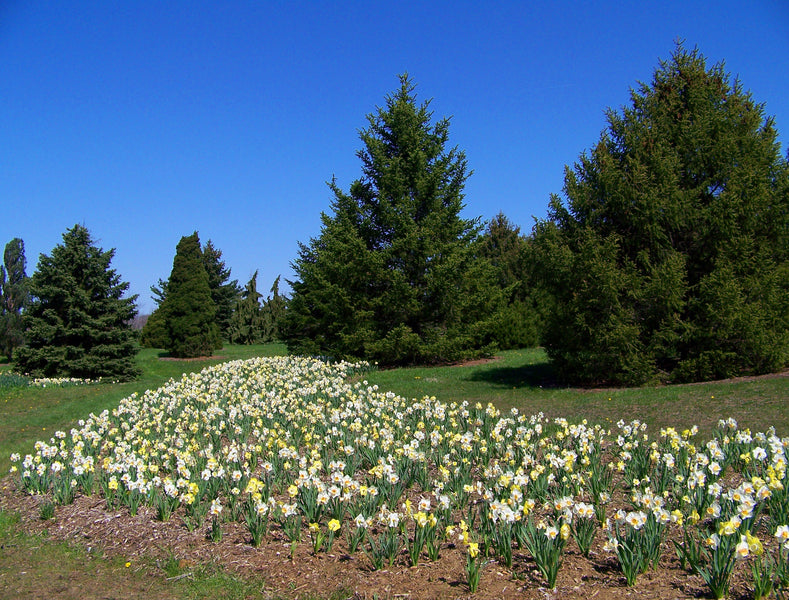It is easy to grow daffodils in grass; through the lawn or meadow areas of your garden. Naturalised daffodils, in the true sense of the word, are the wild species of Narcissus that have spread themselves by seeding around to create wide informal drifts.
One of my favourite areas at the RHS garden Wisley is a wide grassy slope adjacent to the rock garden where in March the entire area is dotted with the dancing trumpets of Narcissus bulbocodium. The soil at Wisley is acidic and this area of mown grass is damp throughout much of the year; ideal conditions for the little Hoop Petticoat daffodil to grow and seed itself freely.

In our gardens we can create similar features by planting such species as Narcissus bulbochodium ‘Golden Bells’ and ‘White Petticoat’ or others such as the somewhat larger growing selections of Narcissus pseudonarcissus.
Unlike the wild species, the many cultivated forms of Narcissus daffodils rarely spread through seeding in the garden but rather by generating larger clumps of the bulbs. Nevertheless, they can be planted in grass in wide drifts to naturalise in the the same way. Better still, because they are larger-growing their impact in the garden can be even more spectacular.
The only drawback to planting daffodils in grass is that it may not be cut until six weeks after the bulbs finish flowering. This allows the leaves to die back naturally during which time they nourish the plant’s bulbs for next years show. At the edges of a lawn such patches of long grass will be less irritating and if organised into patterns, can even become a design feature in their own right.

There is a range of miniature daffodils that are ideal for naturalising in grass that are classified as Jonquilla Narcissus. These sweetly scented daffodils have up to three flowers per stem. The daintiest amongst these are ‘Baby Moon’ and ‘Sundisc’ which will flower in succession and together create a long season of interest.
My favourite Jonquilla narcissus, ‘Pipit’, is somewhat larger-growing with pale yellow petals surrounding its creamy-white trumpets. I have never tried naturalising it in grass, but I regularly scatter it through areas of my perennial borders where I know it will not be overwhelmed by its neighbours. For example, the fresh green and yellow foliage of daylilies emerge very early in spring and make a perfect setting for it.

‘Golden Echo’ is championed by Dutch Grown as one of their best Jonqilla daffodils and as being fantastic for naturalising. It seems to be the reverse and also opposite of ‘Pipit’; the petals are bright white and the trumpets vivid golden yellow. I need to try this one and maybe loosely drift a mix of both through one of my lower-growing meadow schemes.
The Cyclamineus group of daffodils are similarly low-growing and typically have swept back petals as if they are standing facing into a strong head wind. Here we find one of the best known daffodils of all, ‘February Gold’. I always criticised its name as the fresh golden yellow flowers rarely opened before the middle of March in my London garden. Nowadays, the opposite seems to be true. The last few winters have been mild and ‘February Gold’ now flowers before the end of December. What has been so noticeable here is that with the cool temperatures the flowers have remained pristine for weeks on end, indeed well on into February.
‘Jetfire’ is later flowering, but still and early-flowering Cyclamineus narcissus. The neat flowers are bright golden yellow and the trumpets very orange. This striking plant is over used by the parks department in Amsterdam, where I now live, being mass planted alongside roads and on traffic islands. Used in this way they create a spectacular splash of long lasting colour, but this is not how to use them in a private garden. Dotted singly and in small clumps throughout a newly awakening perennial border these perky flowers become exciting and worthy of being repeated to form an early seasonal theme in their own right.

If my garden were big enough to contain an orchard I would not hesitate to copy the use of Narcissus poeticus var. recurvus, the Pheasant’s Eye daffodil, in the grass underneath the trees. This is one of the last species to flower and yet tall enough to be seen above the uncut grass surrounding it. The classic white flowers with a small, tight, yellow centre edged in hard red is both beautiful and visually effective.
Naturalising narcissus in grass or repeating them through perennial borders is one of the best ways of using daffodils in gardens. Once planted there is little more for you to do apart from anticipating their return year on year.

